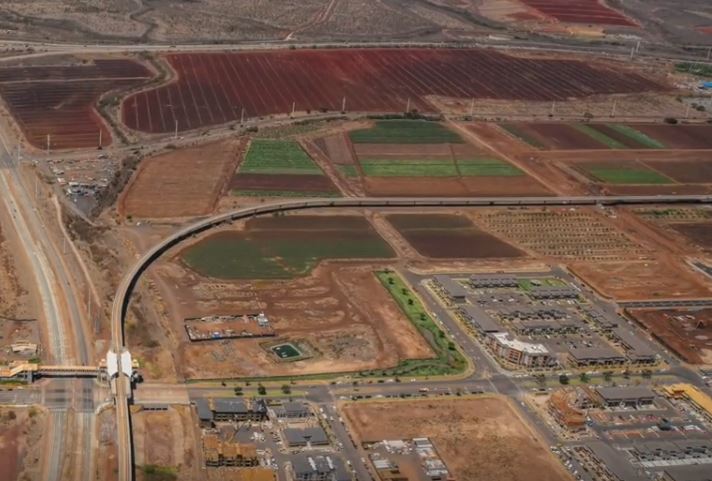Over the next few months, Congress and the White House will haggle over the gory details of what is commonly referred to as the Biden “infrastructure” plan. It’s actually the Green New Deal in disguise and will contain all sorts of goodies for the well-connected.
Don’t be surprised if some of that money ends up being tossed into the bottomless pit that is the Honolulu Authority for Rapid Transit (HART). This is a train that would connect downtown Honolulu with residential neighborhoods on the city’s outskirts, with the initial section running around Pearl Harbor. The 20-mile-long stretch of railway has been under construction for well over a decade, with no end in sight. Completion dates are any body’s guess. Some estimates say 2025, others say 2026, and still another pegs the completion data for 2031. For the record, the project was supposed to be completed in 2020.
City and state officials are looking to Washington for a bailout, and their prospects appear to be good. The Washington Times (April 15) reported that $70 million for the train was tucked into the massive, $1.9 trillion COVID-19 relief bill that passed Congress earlier this year. What does Hawaii’s train to nowhere have to do with COVID? Absolutely nothing. And if Honolulu’s boondoggle can get loot from a COVID bill, just think what it could get from Biden’s green infrastructure proposal.
Each infrastructure fiasco – Boston’s Big Dig, California’s Bullet Train, Maryland’s Purple Line, Washington D.C.’s Metro expansion – has its own story, usually a witch’s brew of corruption and ineptitude on the part of government officials and contractors.
Honolulu’s misadventure began with $65 million in earmarks approved by Congress early in the Obama administration. Like many other projects of that era, this one was declared “shovel ready” by local officials, a ploy to get lawmakers in Washington to fork over the cash. And fork it over they did. According to the office of Sen. Joni Ernst (R-Iowa), U.S. taxpayers have been hit up for $1.8 billion over the years to keep the project on life support. To keep the money flowing, state and local officials simply lied about the project’s status, with a state audit later acknowledging that the initial construction contract was awarded “prematurely.” The original price tag for the project was about $5 billion, but that has now risen to $12.5 billion.
In its reporting of the project, the Washington Times cites numerous examples of what went wrong:
- A former executive director earned $257,000 in salary plus another $42,000 in allowance and stipends, at one point becoming Honolulu’s highest-paid public servant, even though he had no construction experience, according to Honolulu Civil Beat.
- Work was stopped in 2012 after human remains were found on the route, forcing the need for an archeological survey. But contractors who sat idle were still paid, Hawaii Business reported.
- The federal Transportation Department’s inspector general is reviewing claims that the agency overpaid for the real estate to build the project.
- KHON News reported last year that HART blew $900,000 to create a video game, “Outrun da Train.” HART told the outlet that the spending was an obligation as part of its contract, which requires it to do outreach to the community to compensate for digging up historic and cultural resources. Before the video game, HART paid to create a comic book.
- A federal grand jury subpoenaed more than 30,000 documents from HART in 2019 dealing with consultants’ contracts, which were reportedly overwhelming.
“More money isn’t going to get this train back on the rights track,” Sen. Ernst said in a statement. “Now, let’s put the brakes on federal funding for this project – and others like it – once and for all.”
Not a chance. Watch for federal funding to continue to flow to boondoggles like this. The mutual back-scratching in Washington is too ingrained to go away. Projects like Honolulu’s train will be staunchly defended in the name of sustainability, creating green-collar jobs, and – the old standby – combatting climate change by lowering carbon emissions. And taxpayers will be rolled.
Headed for Obsolescence
Sweeping changes in how people earn their living will make rail projects like Honolulu’s increasingly obsolete. The percentage of people commuting daily to downtown offices will continue to decline, as the old routine is replaced by telecommunicating. This trend was already underway pre-COVID-19 and has accelerated during the pandemic. Ridership on Washington’s Metro is down 85% since the beginning of the COVID-related lockdowns. That will rebound somewhat after we get back to normal. But the new normal won’t be the old one. Transit systems everywhere will feel the pinch. Telecommunicating workers, ride hailing services, and, eventually, driverless vehicles will all take their toll on mass transit systems.
The world is changing, but Washington isn’t.
